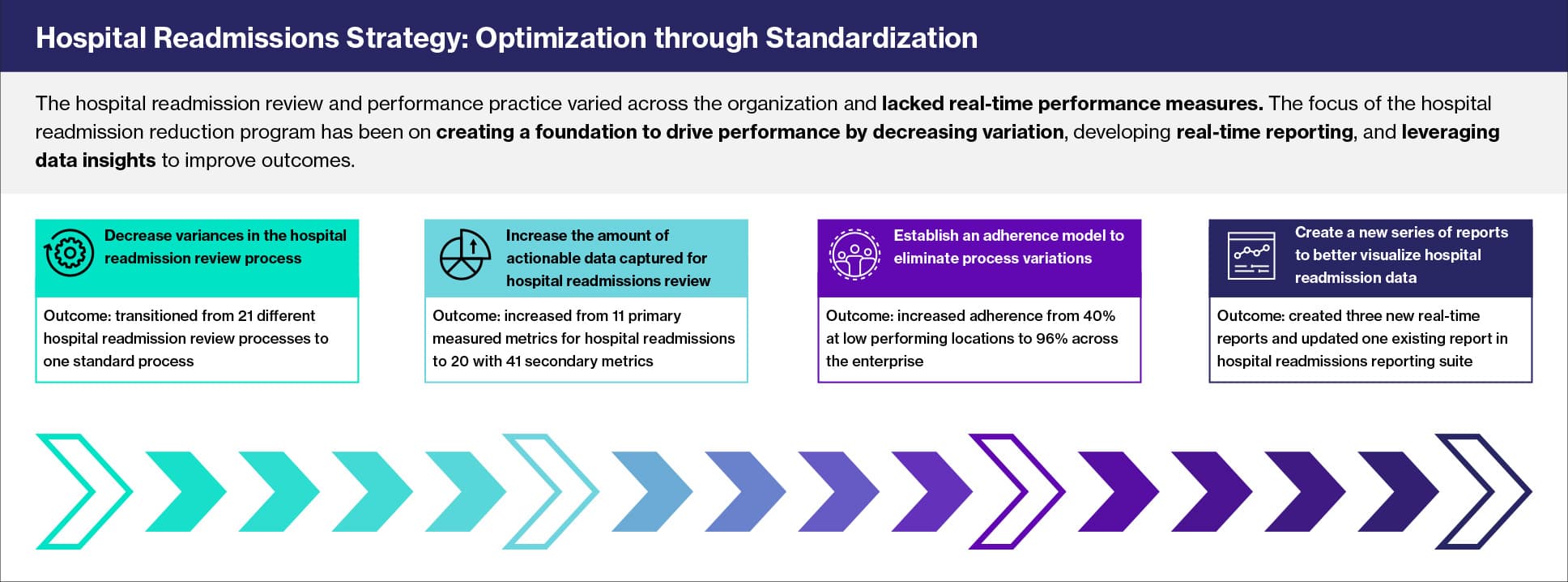Hospital Readmission Reduction Program Saves Healthcare Organization $5.5M in First Year
A large health system sought to gather and analyze data on hospital readmission rates more effectively and efficiently. Staff was spending so much time manually entering readmissions data they didn’t have time to properly analyze and address underlying readmission issues.

Reducing hospital readmissions is known to increase quality improvements in healthcare for patients and decrease unnecessary hospital costs. One of the greatest challenges for reducing hospital readmissions has been adequately tracking – and, ultimately, predicting and preventing – the myriad reasons for readmission. For example, accurately assessing patients’ abilities to properly care for themselves after hospital discharge can be notoriously difficult to predict, requiring a coordinated discharge summary by a multidisciplinary caregiver team to prevent hospital readmission within 24 hours of discharge.
Challenges of Reducing Hospital Readmissions
A large health system with multiple medical centers sought to gather and analyze data on hospital readmission rates across its enterprise to better understand how to reduce hospital readmissions more effectively and efficiently. Problematically, the organization was using its health information system for manual entry of readmissions data, to the point that staff members often cut and pasted data across systems. Due to this organization’s high patient volume, staff was spending so much time manually entering readmission data that they didn’t have time to properly analyze and address underlying readmission issues.
The organization knew it needed a better way to handle its hospital readmissions data but lacked the objectivity and bandwidth to properly assess its needs and create an enterprise-wide solution. Freed Associates (Freed) partnered with the organization to identify and establish a better way of handling readmission data and reducing hospital readmissions. Through Freed’s efforts, hospital readmission data became available in near real-time, and the organization was set up to save millions of dollars per year.
A Better Path for How to Reduce Hospital Readmissions
Freed and the client established four goals at the outset of the project to reduce hospital readmissions:
- Decrease variances in the organization’s hospital readmission review process
- Increase the amount of actionable data captured for hospital readmissions review
- Establish an adherence model to eliminate process variations
- Create a new series of reports to better visualize hospital readmission data
Freed and the organization also concurrently established a set of metrics to assess the success of this effort, based on hospital readmission reduction rates overall, as well as on reduced emergency department and inpatient utilization and costs.

System Optimizations Improve Hospital Readmissions Review
Freed began by analyzing the current state of the organization’s hospital readmission review process and defining new standards for readmission review optimization. Due to the organization’s expansive geographic size, it was important to create consistency across the organization around hospital readmission data-gathering and reduction practices. Thus, Freed collected input on process improvements from multidisciplinary teams across the enterprise.
Based on the input Freed collected and previous healthcare consulting implementation experience, a readmission review improvement plan was established that focused on data accuracy, process efficiency and improved user experience. Freed worked with the organization’s technical team to develop a new enterprise-wide platform for gathering readmission data using SharePoint, replacing the manual and antiquated legacy system. The new SharePoint system would auto-extract necessary data from the organization’s health information system to make this information more widely available for analysis.
The streamlined system and process for estimating real-time hospital readmissions data reduced the time it took data to become available from three months to one day. Suddenly, staff members could see a daily estimated readmission number just a day after patients were readmitted.
Healthcare Organization Reduces Readmissions through Data Visibility
Enhanced readmissions data visibility through dashboards made this information more widely available to pertinent staff enterprise wide. Adherence reports were reviewed by senior executives on a regular basis to confirm the new hospital readmission data process was being followed consistently across the enterprise. Data transparency increased adherence from 40% at low-performing locations to 96% across the enterprise.
Using the enhanced data, an interdisciplinary team began meeting weekly to review hospital readmissions and identify opportunities to reduce readmissions. With new hospital readmission data available, the organization is creating forums focused on information and best-practice sharing to reduce readmissions.
Freed’s efforts enabled staff to break free from their prior cut-and-paste and manual data entry habits, and instead spend their time more productively on analyzing hospital readmission rates and trends. From this newfound information, staff members were now able to develop new steps and methods for reducing hospital readmissions.
$5.5 Million in Healthcare Cost Savings by Reducing Hospital Readmissions
As a result of this effort, the healthcare organization reduced hospital readmissions and achieved cost savings of $5.5 million in year one and significantly improved patient outcomes. The organization expects similar annual savings in future years.
Through Freed’s efforts, there is now consistent use of the SharePoint hospital readmission data-tracking tool across all facilities within the organization. This consistency and availability of near real-time hospital readmissions data enable a weekly analysis and review of hospital readmissions by an interdisciplinary team charged with trendspotting. The organization can now focus on implementing process improvements in healthcare and programs to reduce hospital readmissions.





